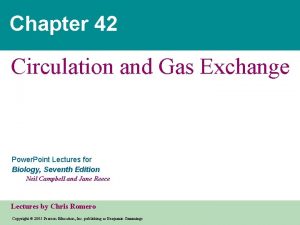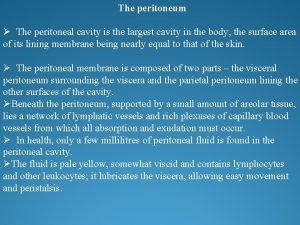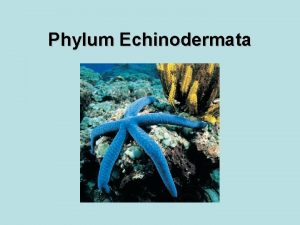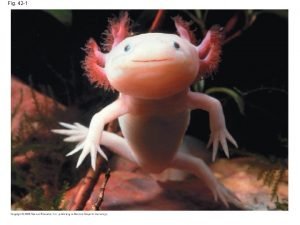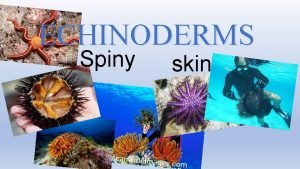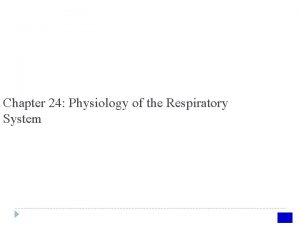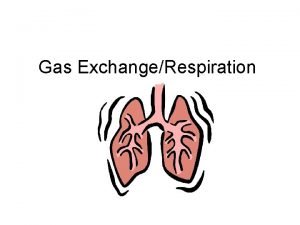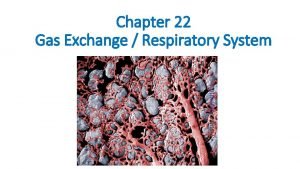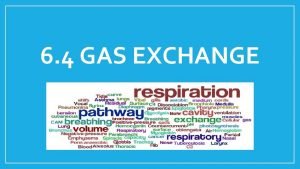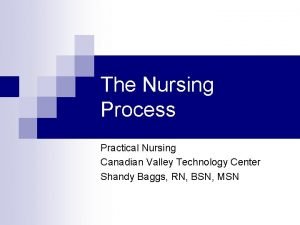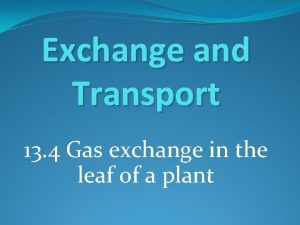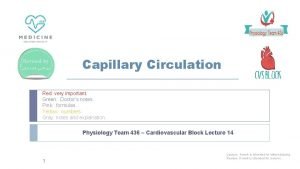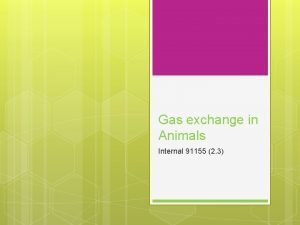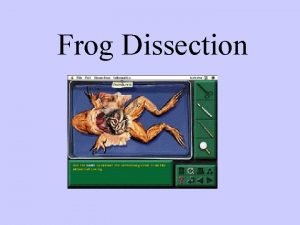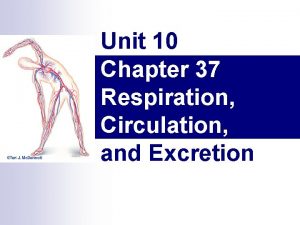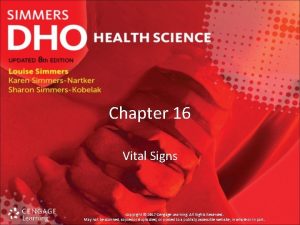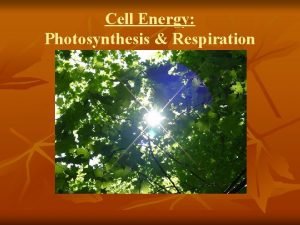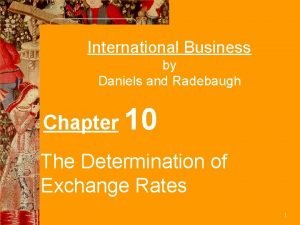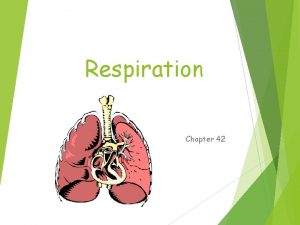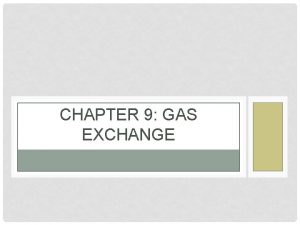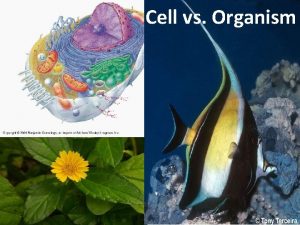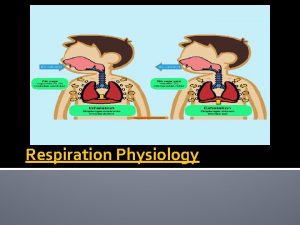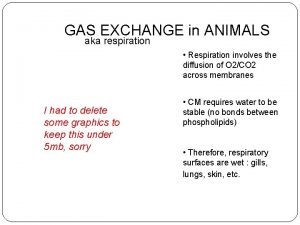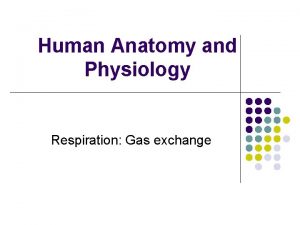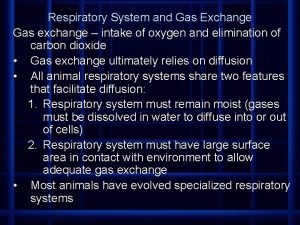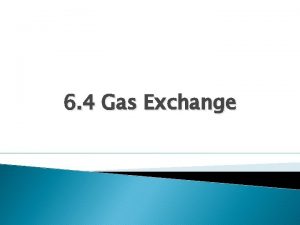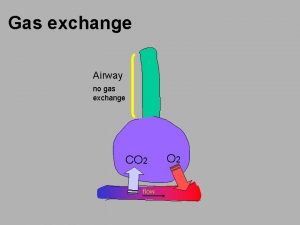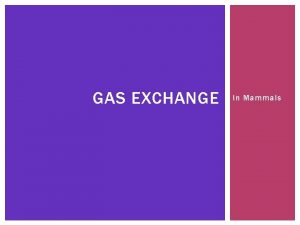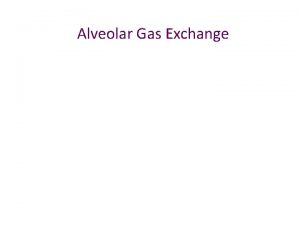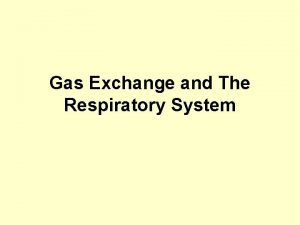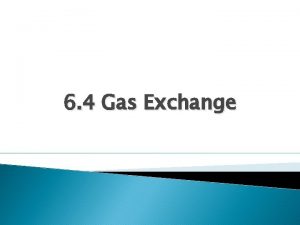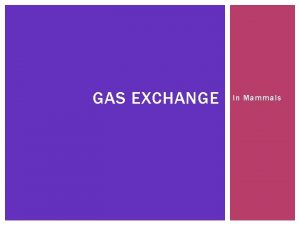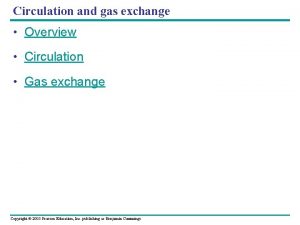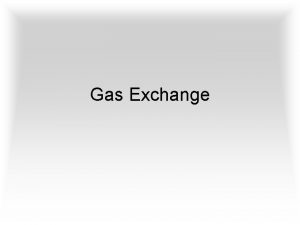Respiration Chapter 42 Respiration Gas exchange Movement of














































- Slides: 46

Respiration Chapter 42

Respiration ® Gas exchange ® Movement of gas across membrane ® Diffusion (passive) ® To improve gas absorption ® Increase surface area for diffusion ® Decrease distance diffused gas travels

Respiration ® Advanced organisms ® Respiratory organs ® Increases surface area ® Allow greater diffusion rates ® External environment is closer to internal fluids

Fish ® Gills located behind the buccal (mouth) cavity ® Fish swims with mouth open ® Water flows over gills ® Gills contain blood vessels ® Absorb O 2

Fish

Land animals ® 1. Gills flatten out in air ® 2. Water loss to air is too great with gills

Amphibians ® Lungs ® Out pouching of gut ® Connected to pharynx ® Positive pressure ® Open mouth fill buccal cavity with air ® Close mouth elevate floor of mouth ® Forces air into lungs ® Cutaneous respiration

Amphibians

Birds ® Parabronchi (lungs) ® Gas exchange happens ® 2 groups of air sacs ® Anterior, posterior ® Inhales ® Air enters ® Posterior sacs fills with outside air ® Anterior sacs fills with air from lungs

Birds ® Exhales ® Air is forced out ® Posterior sacs empties in the lung ® Anterior sacs is exhaled

Fig. 42 -26 Anterior air sacs Posterior air sacs Air Trachea Lungs Air tubes (parabronchi) in lung INHALATION Air sacs fill EXHALATION Air sacs empty; lungs fill 1 mm

Anatomy ® Mouth (nose) ® Pharynx (back of throat) ® Larynx (voice box) ® Trachea

Anatomy

Anatomy

Anatomy ® Bronchi (Bronchus) ® Bronchioles ® Alveoli ® Air sacs ® Gas exchange ® One cell layer thick ® Lung tissue consists of millions

Anatomy

Anatomy

Anatomy ® Lungs ® 3 right lobes ® RUL, RML, RLL ® 2 left lobes ® LUL, LLL

Anatomy

Anatomy


Anatomy ® Lung covered by a double folded membrane ® Visceral pleural membrane: ® Covers the lung ® Parietal pleural membrane: ® Lines inner wall of thoracic cavity

Anatomy ® Pleural cavity: ® Space between two membranes ® Filled with fluid ® Helps with movement of lungs

Breathing ® Diaphragm ® Muscle ® Separates thoracic cavity from abdominal cavity ® Intercostal muscles ® Muscles between the ribs

Inhalation (inspiration) ® Diaphragm contracts & flattens ® Intercostal muscles contract ® Raises the ribs ® Increases volume (decreases pressure) ® Air flows into the lungs

Exhalation (expiration) ® Diaphragm relaxes & elevates ® Intercostal muscles relax ® Ribs lower ® Decreased volume ® Forces air out

Breathing

Breathing measurements ® Tidal volume ® Amount of air moved into & out of lungs at rest ® Vital capacity ® Maximum amount of air that can be expired after forceful exhalation

Breathing measurements

Control of breathing ® Normal breathing ® Medulla oblongata ® Respiratory control center ® Neurons send impulse for muscles (diaphragm/intercostal) to contract ® Inspiration (inhalation) ® Stop sending impulse ® Expiration (exhalation)

Control of breathing ® Blood O 2 & CO 2 in normal range ® Neurons respond to a change in O 2 & CO 2 ® More response to CO 2 ® Increases carbonic acid (H 2 CO 3) ® CO 2 + H 2 O ⇆H 2 CO 3 ⇆ H + HCO 3 ® Lowers p. H

Control of breathing ® Stimulates peripheral chemoreceptors ® Aorta & carotids ® Send impulses to respiratory control center (medulla oblongata) ® Stimulates increased breathing

Control of breathing ® Central chemoreceptors ® Located in brain ® Respond to increased amount of CO 2 ® Peripheral receptors immediate response ® Central receptors maintained response until p. H is back to normal

Transport of gas ® Hemoglobin ® Contains four heme groups ® Center of each heme group is an iron ® Oxygen binds the iron (4 O 2 molecules) ® Oxygen in blood is mostly bound to Hgb ® Little is dissolved plasma

Transport of gas

Transport of gas ® Oxyhemoglobin ® Hemoglobin full of oxygen ® Lungs ® Deoxyhemoglobin ® Hemoglobin ® Capillaries releases some oxygen

Transport of gas E: Chapter_42A_Power. Point_Lectures42_L ecture_Presentation42_30 CO 2 Tissues. To. Blo od_A. html E: Chapter_42A_Power. Point_Lectures42_ Lecture_Presentation42_30 CO 2 Blood. To. L ungs_A. html E: Chapter_42A_Power. Point_Lectures42_Lectu re_Presentation42_30 O 2 Lungs. To. Blood_A. html

Transport of gas ® Blood that leaves lungs 97% saturated ® Circulates oxygen diffuses into tissues ® 75% saturated ® Allows for reserves of oxygen ® Exercise ® Cardiac arrest

Transport of gas ® Decreased p. H ® Lower affinity of oxygen for hemoglobin ® Releases oxygen ® Increased temperature ® Lower affinity ® Exercise ® Increased CO 2, decreased p. H, increased temperature ® Increased release of O 2 to muscles

Transport of gas ® CO 2 ® In tissues ® Small amount bound to protein part of Hgb ® Remaining CO 2 in RBC ® Forms carbonic acid H 2 CO 3 ® Carbonic anhydrase

Transport of gas ® Carbonic acid separates ® Bicarbonate (HCO 3 -1) & H+1 ® Buffer ® Blood at alveoli ® Carbonic anhydrase reverses ® Forms water & CO 2 ® CO 2 diffuses into lungs

Abnormalities ® Emphysema ® Lung disease that destroys alveoli sacs ® Decreases vital capacity ® Traps air ® Hypoventilation ® Decreased air movement increased CO 2 ® Hyperventilation ® Increased air movement decreased CO 2

Emphysema



 Gas exchange key events in gas exchange
Gas exchange key events in gas exchange Chapter 42 circulation and gas exchange
Chapter 42 circulation and gas exchange Internal respiration vs external respiration
Internal respiration vs external respiration Respiration
Respiration Normal abdominal movement with respiration
Normal abdominal movement with respiration Real exchange rate formula
Real exchange rate formula Voluntary exchange activity the pearl exchange
Voluntary exchange activity the pearl exchange Light gun signals
Light gun signals Axial in dance
Axial in dance Gas exchange in circulatory system
Gas exchange in circulatory system Sea star cephalization
Sea star cephalization Fig 42
Fig 42 Countercurrent exchange in fish
Countercurrent exchange in fish What is an echinoderm
What is an echinoderm What is the physiology of respiration
What is the physiology of respiration Gas exchange in worms
Gas exchange in worms Adaptations of xerophytes
Adaptations of xerophytes Egrette ch 22
Egrette ch 22 How is amoeba adapted for gas exchange bbc bitesize
How is amoeba adapted for gas exchange bbc bitesize Gas exchange
Gas exchange Impaired gas exchange subjective data
Impaired gas exchange subjective data Section 26-2 sponges
Section 26-2 sponges Gas exchange
Gas exchange Capillary tissue fluid exchange diagram
Capillary tissue fluid exchange diagram Mechanism of breathing
Mechanism of breathing Gas exchange in plants and animals venn diagram
Gas exchange in plants and animals venn diagram Frog
Frog Derive ideal gas equation
Derive ideal gas equation An ideal gas is an imaginary gas
An ideal gas is an imaginary gas Differences between ideal gas and real gas
Differences between ideal gas and real gas Sutherland's law
Sutherland's law Conclusion
Conclusion Gas leaked in bhopal gas tragedy
Gas leaked in bhopal gas tragedy Volume molare
Volume molare Flue gas desulfurisation gas filter
Flue gas desulfurisation gas filter Poisonous gas leaked in bhopal gas tragedy
Poisonous gas leaked in bhopal gas tragedy Difference between ideal gas and real gas
Difference between ideal gas and real gas Reaksi pembentukan gas no2f dari gas no2 dan f2
Reaksi pembentukan gas no2f dari gas no2 dan f2 Chapter 37 respiration circulation and excretion
Chapter 37 respiration circulation and excretion Chapter 8 section 3 cellular respiration
Chapter 8 section 3 cellular respiration 16.7 measuring and recording blood pressure
16.7 measuring and recording blood pressure Oxidative phosphorylation enzymes
Oxidative phosphorylation enzymes Explain how amp stimulates cellular respiration
Explain how amp stimulates cellular respiration Chapter 9: cellular respiration: harvesting chemical energy
Chapter 9: cellular respiration: harvesting chemical energy How do plants get glucose
How do plants get glucose Has the exchange rate changed chapter 10
Has the exchange rate changed chapter 10 Has the exchange rate changed chapter 10
Has the exchange rate changed chapter 10

